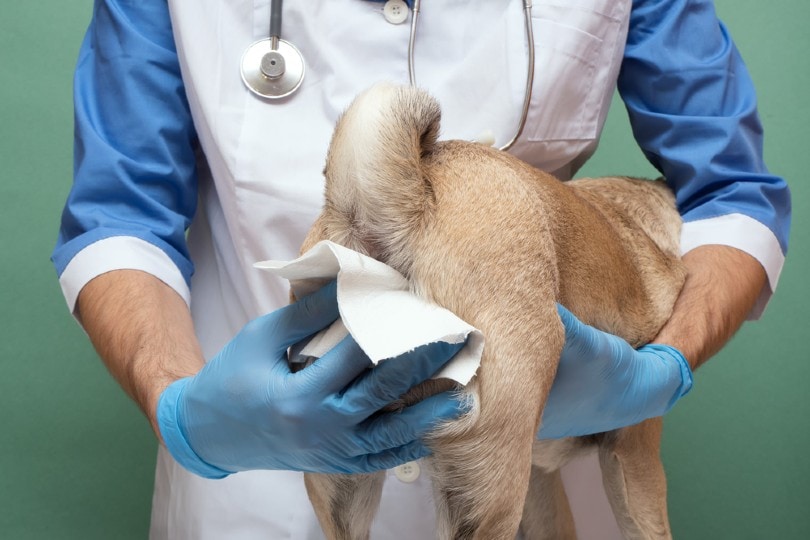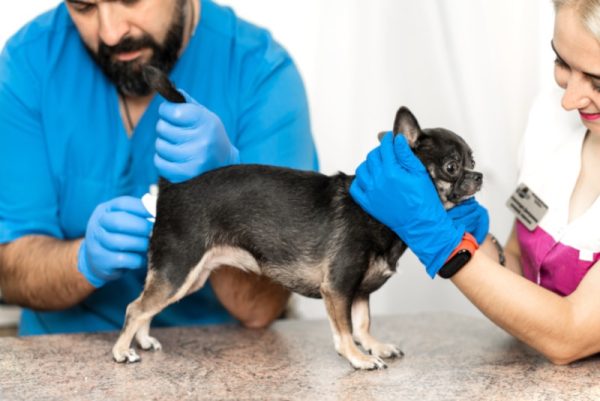If you have ever noticed your dog rub their butt on your carpet, it can be a sign of an uncomfortable condition called anal sac disease. Anal sac disease happens when there is an inflammation of the anal gland ducts causing swelling and impaction, or when there hasn’t been enough pressure on the glands to empty them fully or properly, sometimes due to ongoing diarrhea. Then, your dog’s anal glands fill up.
This condition can be recognized by the swelling of your dog’s anal area, pain or discomfort, and even an unpleasant discharge and odor. While this condition isn’t life threatening for your dog, it is important to treat it promptly at your vets, as it’s quite painful for your pooch.
In the article below you can find more information about anal sac disease and how to deal with your dog’s anal glands filling up.

What Is the Purpose of Anal Glands in Dogs?
Every dog has two anal sacs located on the lower sides of the anus. There are several purposes for anal glands in dogs. These sacs provide other dogs with crucial information so you can often see them sniffing on this area of the other dog’s body and their feces as well. When dogs have bowel movements, these anal sacs excrete fluids. This is another crucial role that these anal glands play. They can also serve as territorial markers. Some dogs may empty their anal glands spontaneously when excited, stressed, or scared.

Blocked Anal Glands
The blockage of anal glands, or anal sac disease, is fairly common in dogs. As you can imagine, this condition can become very uncomfortable and painful and interrupt normal bowel movement. These sacs become swollen, painful, and distended when they become blocked or impacted. Bacteria that are commonly found in feces can travel up the ducts into the anal sacs.
When the anal sacs are inflamed or infected, abscess can begin forming in one or both sacs, and the fluid inside is the perfect ground for bacterial development. This abscess is extremely painful to a dog, causing swelling of one or both sides of the anus. Other than an infection and abscess, older dogs in particular may develop an anal gland tumor that can initially present similarly to an impaction, as it manifests as a swelling. Any anal gland issues need to be checked by the vet.
Consulting a veterinarian is recommended for the best course of action.
If you need to speak with a vet but can’t get to one, head over to PangoVet. It’s an online service where you can talk to a vet online and get the personalized advice you need for your pet — all at an affordable price!

How to Tell if a Dogs Anal Glands Are Full
As we’ve mentioned above, one of the most prominent signs of the dog’s anal sacs being inflamed or full is the swelling of the area around the anus. You will also notice your dog scooting their bottom against the floor and excessively licking the base of the tail. Because anal sac disease is a painful condition, your dog may even snap at you when you try touching their tail or anal area, particularly if there is swelling or an abscess.
- Scooting or rubbing their bottom against the floor
- Excessive licking of the base of their tail
- Difficulty pooping
- Unpleasant odor
- Bloody stool, bloody discharge, or pus around the anus
- Aggressive behavior when touching their anus or tail
Causes of Anal Glands Filling Up

The most common cause of the anal sacs filling is when there is an inflammation or an infection or there hasn’t been enough pressure on the glands to empty them. This usually occurs when the dog has had diarrhea for several days. When these glands remain full for too long, they may swell up and become contaminated with bacteria from the feces. Some of the causes are not yet fully clear, but most common risk factors may include:
- Obesity
- Insufficient fiber in their diet
- Chronic diarrhea or soft stool
- Constipation
- Food allergies
Prevention of Anal Gland Problems in Dogs
To prevent the blockage or inflammation of the anal sacs, regular veterinary visits are crucial. Creating an ideal meal plan for your dog is also important. Discuss potential food allergies and atopic dermatitis investigations with your veterinarian, and seek advice for the perfect diet and medication, as there seems to be a yet unclear link between allergies and anal gland issues.
Sticking to commercial dry food or kibble would be best, as these are least likely to irritate your dog’s stomach. If your dog has problems pooping, your veterinarian may suggest including more fiber in their diet or other additions, such as fish oil, cooked fresh pumpkin, or unsalted pumpkin seeds.
If your dog exhibits any signs of anal sac disease, take them to your veterinarian as soon as possible.

Final Thoughts
After reading the article above, you should be able to recognize the signs of the anal gland blockage or abscess early on. It is best to prevent this issue by consulting with your vet, who may recommend including a proper fiber-rich diet for your dog. Since this condition occurs mainly in dogs with chronic diarrhea or allergies, controlling their diet and ensuring it is high-quality may go a long way in preventing the issue.
See Also:
- Dog Anal Glands: Everything You Need to Know (Ask a Vet)
- How to Get Rid of Dog Anal Gland Smell: 5 Vet Approved Tricks
Featured Image Credit: Try_my_best, Shutterstock












